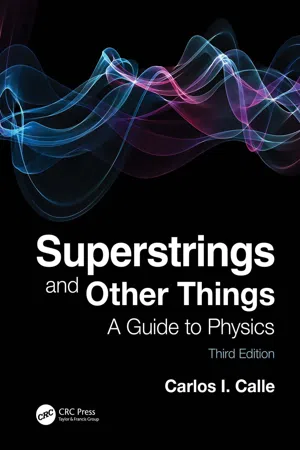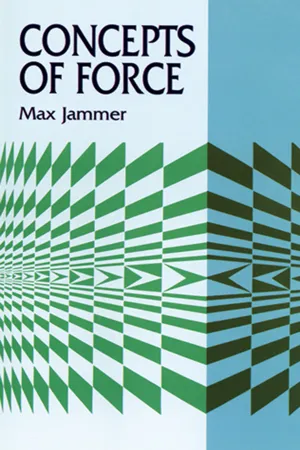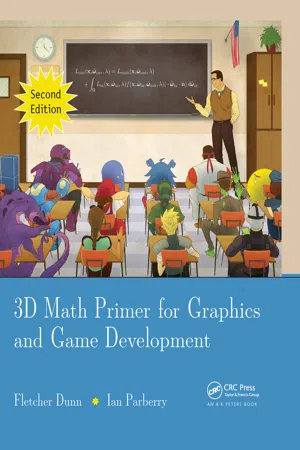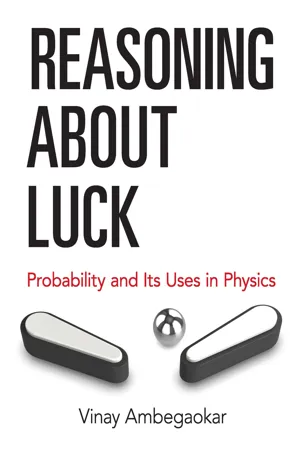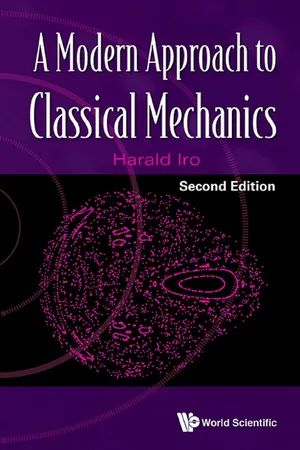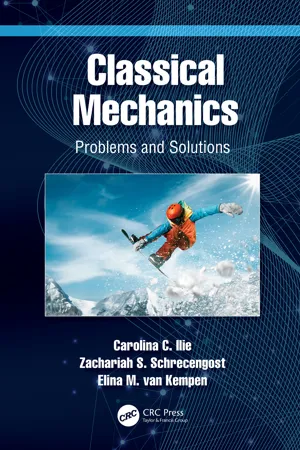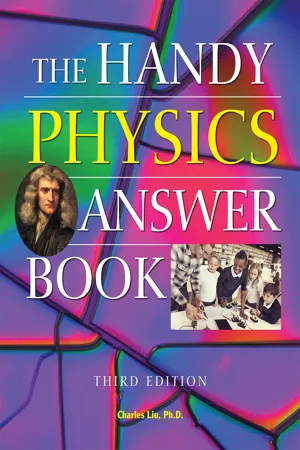Mathematics
Newton's Second Law
Newton's Second Law states that the force acting on an object is equal to the mass of the object multiplied by its acceleration. This law is expressed by the equation F = ma, where F represents force, m is mass, and a is acceleration. It provides a quantitative relationship between the force applied to an object and the resulting acceleration.
Written by Perlego with AI-assistance
Related key terms
10 Key excerpts on "Newton's Second Law"
- eBook - ePub
- Hiqmet Kamberaj(Author)
- 2021(Publication Date)
- De Gruyter(Publisher)
These examples indicate that the acceleration of an object is directly proportional to the resultant force acting on it. The acceleration of an object should also depend on its mass. For example, consider the following experiment: If you apply a force F to a block of ice moving on a horizontal frictionless surface, then the block undergoes some acceleration, a. If you double the mass of the block, then the same applied force produces an acceleration of a / 2. If the mass is tripled, then the same applied force delivers acceleration of a / 3, and so on. This observation indicates that the magnitude of the acceleration of an object is inversely proportional to its mass. These observations lead to Newton’s second law. Newton’s second law The acceleration of an object is directly proportional to the net force acting on it and inversely proportional to its mass. We can relate mass and force using the following expression, which represents a mathematical statement of the second law of the Newton: (5.7) ∑ i F i = m a. Since this expression is a vectorial equation, we can project along the three coordinate axes as follows: (5.8) ∑ i F x i = m a x (5.9) ∑ i F y i = m a y (5.10) ∑ i F z i = m a z. In the SI unit system, the force has the units of newton (N), which is defined as the force acting on a mass of 1 kg gaining an acceleration. of 1 m/s 2. From the definition of Newton’s second law, we see that the newton can be expressed in terms of the units of mass, length, and time as follows: (5.11) 1 N ≡ 1 kg · m s 2. In the engineering system or British system, the unit of force is pound, which is defined as the force acting on a mass of 1 slug 1 to produce an acceleration of 1 ft/s 2 : (5.12) 1 lb ≡ 1 slug · ft/s 2. An approximation is (5.13) 1 lb ≈ 1 4 N. 5.5 Newton’s third law When we press against a corner of a textbook with the fingertip, the book pushes back and makes a small dent in our skin - eBook - ePub
Doing Physics with Scientific Notebook
A Problem Solving Approach
- Joseph Gallant(Author)
- 2012(Publication Date)
- Wiley(Publisher)
Chapter 5Newton’s Laws of Motion
In the previous chapters on kinematics, we described motion in a quantitative sense. Once we know an object’s acceleration, we can describe its motion in terms of position, velocity, and time. Knowing how its motion changes lets us calculate how far, how fast, and how long the object moves.Now we move to a branch of physics known as dynamics. Dynamics is the study of the effects of forces on an object’s motion. Dynamics explains changes in motion by relating the cause of the changes (forces) to the effect (acceleration). Newton’s Second Law provides the rule relating the acceleration to the net force.There are three ingredients to Newton’s Second Law: the object’s acceleration, mass, and the net force acting on it. As we discussed in Chapter 2, the object’s acceleration is the rate of change in its velocity. Mass is a property of the object that determines how much change the net force produces. An object’s mass tells you how difficult it is to change its velocity and how much matter it has.A force is a push or a pull that can cause changes in motion. Forces are vectors, so they have magnitude and direction. This is consistent with your experience. When you exert a force on something, two things matter: how hard you push or pull and which way. Often objects have more than one force acting on them. The net force acting on an object is the vector sum of all the forces acting on it.Newton’s First Law
Newton’s First Law tells us what happens when there is no net force acting on an object.Newton’s 1st Law: An object will remain in a state of rest or continue in motion at a constant velocity unless compelled to change by a non-zero net force.When there is no net force acting on the object, there is no change in the object’s velocity. If it is at rest, it remains at rest. If it is moving, it keeps moving at constant velocity. Since velocity is a vector, constant velocity means no change in both speed and direction. Motion at constant velocity is motion in a straight line at a constant speed. - eBook - ePub
Newtonian Dynamics
An Introduction
- Richard Fitzpatrick(Author)
- 2021(Publication Date)
- CRC Press(Publisher)
Nowadays, Newton’s first law strikes us as almost a statement of the obvious. However, in Galileo’s time, this was far from being the case. From the time of the ancient Greeks, philosophers—observing that objects set into motion on the Earth’s surface eventually come to rest—had concluded that the natural state of motion of objects was that they should remain at rest. Hence, they reasoned, any object that moves does so under the influence of an external influence, or force, exerted upon it by some other object in the universe. It took the genius of Galileo to realize that an object set into motion on the Earth’s surface eventually comes to rest under the influence of frictional forces, and that, if these forces could somehow be abstracted from the motion then the motion would continue forever.4.3 Newton’s Second Law of Motion
Newton used the word “motion” to mean what we nowadays call momentum. The momentum, p, of a body is defined as the product of its mass, m, and its velocity, v; that is,Newton’s second law of motion is summed up in the equationp = m v .(4.2)(4.3)= f ,d pd twhere the vector f represents the net influence, or force, exerted on the object, whose motion is under investigation by other objects in the universe. For the case of a object with constant mass, the previous law reduces to its more conventional formm a = f .(4.4)In other words, the product of a given object’s mass and its acceleration,a = d v / d t, is equal to the net force exerted on that object by the other objects in the universe. Of course, this law is entirely devoid of content unless we have some independent means of quantifying the forces exerted between different objects.4.4 Measurement of Force
One method of quantifying the force exerted on an object is via Hooke’s law. (See Section 5.6 .) This law—discovered by the English scientist Robert Hooke in 1660—states that the force, f, exerted by a coiled spring is directly proportional to its extension,Δ x - eBook - ePub
Superstrings and Other Things
A Guide to Physics
- Carlos I. Calle(Author)
- 2020(Publication Date)
- CRC Press(Publisher)
In the first case, for a constant mass (the sports car), the applied force is proportional to the acceleration produced. In the second case, for a given acceleration (0–5 km/h), the applied force is proportional to the mass of the object, larger for the larger mass of the wagon and smaller for the smaller mass of the sports car. We can combine these two proportionality expressions into a single equation:F = m awhich is the mathematical expression for Newton’s second law. In converting from proportionality to equality, a constant is usually introduced. In this case, however, if SI units are used, the constant is unity. Notice that F and a are both vector quantities.We can restate the second law as follows:The acceleration of an object is directly proportional to the net force acting on it and inversely proportional to its mass.The SI unit of force is the newton (N), defined as the force that produces an acceleration of 1 m/s2 when acting on a 1-kg mass. From this definition, we can write:1 N = 1 kgm/s 2.In Newton’s second law, it is the net force F acting on an object of mass m that produces an acceleration a.Pushing Single AtomsIt takes 17 piconewtons to push a cobalt atom along a copper surface and 219 pN to push it over a platinum surface. Researchers at IBM’s Almadén Research Center and at the University of Regensburg in Germany used an atomic force microscope to measure for the first time the force required to push atoms across different surfaces. Their goal is to learn about the way atoms interact with the surfaces that they rest on. The scientists hope that this knowledge can lead to an increase in the miniaturization of computer chips. This research can help IBM researchers experimenting with ways to arrange strands of carbon atoms that conduct electricity—carbon nanotubes—into arrays with DNA molecules. After the nanotube array is constructed, the DNA molecules can be removed. This ordered nanotube grid could work as a data storage device. - eBook - ePub
- Max Jammer(Author)
- 2012(Publication Date)
- Dover Publications(Publisher)
ultima ratio in his reasoning was, of course, the law of inertia. To make it quite clear, we do not suppose that Newton inferred his second law from the laws of impact; such an inference would have met with insuperable conceptual and mathematical difficulties. Ultimately, it was a stroke of genius, a “free creation of the human mind.”The first two laws of motion add little information on Newton’s concept of force that is not contained in the preceding definition. The third law, however, supplies an additional important characteristic of force not mentioned previously: force manifests itself invariably in a dual aspect; it is action and reaction simultaneously. Much as a business transaction can be regarded both as a purchase and as a sale of the same amount, force can be considered as action as well as reaction of the same magnitude. As far as attraction is concerned, Newton believes himself capable of demonstrating the validity of the third law as follows: Suppose the two bodies A and B attract each other; imagine, now, that A , for example, attracts B with greater intensity than B attracts A ; suppose also that an obstacle is interposed to prevent the meeting of these two bodies; our assumption would then lead to the conclusion that the whole system (A -obstacle-B ) would move in the direction from B to A , for the obstacle, as Newton puts it, “will be more strongly urged by the pressure”309 of the body B than by the pressure of the body A and consequently will not remain in equilibrium, but accelerate in infinitum.It is generally contended that Newton’s statement of the third law is “his most important achievement with respect to the principles”310 of mechanics. Without diminishing Newton’s outstanding merits in the foundation of classical mechanics in the least, it should be recalled that Kepler had already a clear conception of the reciprocity of force,311 - eBook - ePub
- Fletcher Dunn, Ian Parberry(Authors)
- 2011(Publication Date)
- A K Peters/CRC Press(Publisher)
a form you will more commonly see.12.3.1 Conservation of Momentum
Let’s return to our investigation into what happens when Moe pushes against the Earth to get his box moving. Newton’s law tells us that the Earth, not having anything else to push back on, receives a net force, and thus an acceleration (and a torque, which we discuss later). Yes, you cause the Earth to accelerate when you push boxes as well as when you take each and every step! Of course, the Earth’s mass is so large compared to Moe’s force that this acceleration is small. Not only that, but Moe’s force pushing the box to the east might be canceled out by Joe’s force in North Dakota pushing his box to the west at the same time. An issue even more important than these two facts involves the “accounting laws” of physics: “there is no such thing as free momentum.” Moe doesn’t need Joe to balance out his force; as it turns out, he can’t help but do it all by himself!Observe that once Moe sets the box in motion, he will need to eventually stop it. According to Newton’s first law, the only way to stop a moving box is through a force, and according to the third law, this can happen only if there is some other object involved to receive the opposite force. Perhaps the box bumps into a tree and comes to a stop. (We consider the tree to be part of the Earth. Remember that Newton’s third law justifies our treatment of connected objects as a single object, provided that they remain rigidly connected.) To stop the box, the Earth must push against it with a force that is in the opposite direction that Moe pushed to start it moving. However, we know that the “total amount” of pushing must be the same, meaning the Earth must push back with a strong enough force, or for a long enough duration (perhaps Moe’s box rolls into a patch of tall grass) to bring the momentum of the box down to zero. So you see that whatever acceleration the Earth received as a result of getting Moe’s box in motion must always be exactly canceled by the force required to bring the box to a stop. - eBook - ePub
- Vinay Ambegaokar(Author)
- 2017(Publication Date)
- Dover Publications(Publisher)
Suppose that an object is moving steadily around a circle of radius one meter at such a rate that it makes one circuit in 2 π seconds, i.e. approximately 6.28 seconds. Then, using (6.6), we find that its acceleration towards the center is one mks unit – one meter/(second) 2. If the object has a mass of one kilogram, Newton’s second law then informs us that this requires a steady force pulling it towards the center of one mks unit of force, or one newton. The one other situation I would like to explain is easier to understand : constant acceleration in the direction of the velocity. This is, approximately, what happens when an object is dropped from a window. [Approximately because the gravitational force is not the only force acting on such a falling object; there is air resistance as well.] The force of gravity is proportional to the mass of the object; this force causes all bodies falling near the surface of the earth to accelerate downward at the same rate, which in mks units is approximately 9.81 m/ s 2. An object released from rest thus picks up downward velocity as it accelerates. The ubiquity of frictional forces opposing motions in our everyday world makes it easy to understand why astronomical observations played such an important role in the insights of Newton and his contemporaries. On the other hand, although the original impetus for the development of mechanics may have been the explanation of celestial motions, one of Newton’s great triumphs was the unification of celestial and terrestrial dynamics. We are very close to being able to understand this synthesis. What follows is a small digression in that direction - eBook - ePub
- Harald Iro(Author)
- 2015(Publication Date)
- WSPC(Publisher)
, the basic equations are as follows:• The momentum p = (p1 , p2 , p3 ) of a body is the product of its mass m and its velocity v:• A force F is represented by a vector in configuration space, F = (F1 , F2 , F3 ). If two forces F1 and F2 are applied to a point on a body, then the total force F is the vectorial sum of both forces:(superposition principle of forces).• The first two laws of Newton relate the change of momentum (‘quantity of motion’) of a body with the force applied to it; these are summarized in an equation that we call Newton’s equation of motion16 :(p = const, if F = 0 (1st law)). If the mass m is time independent, then the change in velocity, i.e. the acceleration d2 r/dt2 = , is a measure of the force:Written in components, we have• The third law relates the forces that two bodies exert on each other:where Fikis the force applied by body k to body i (action = reaction).The superposition principle for forces represents the starting point for statics, a subject of great importance in engineering. We present a short introduction to statics in Section 11.2 .2.3.2 Point masses and forces
In the following, we apply Newton’s definitions and laws to so-called point masses. By definition, point masses are mathematical points having mass; they have no structure, like a body. Therefore, the only possibility for a point mass to change, is to move. Since motion can occur in three independent directions, the number of degrees of freedom of a point mass is three. At first, the concept of point mass is assumed to apply to real situations, when the bodies or particles involved are of sizes negligible with respect to the typical length scales (e.g. the distances between the bodies) of the systems considered – the particles are taken to be mathematical points. Thereby the internal structure and the internal degrees of freedom17 of the particles are ignored. Then, starting from the concept of point mass, by a natural extension, the motion of extended bodies lies within the scope of the mechanics of point masses (see, for instance, the treatment of rigid bodies in Chapter 11 - eBook - ePub
Classical Mechanics
Problems and Solutions
- Carolina C. Ilie, Zachariah S. Schrecengost, Elina M. van Kempen(Authors)
- 2022(Publication Date)
- CRC Press(Publisher)
Principia Mathematica.1.1.3.1 Newton's First Law – The Law of Inertia
A particle maintains the state of rest or the state of motion with constant velocity as long as no net force is acting on it.Inertia is the property of objects with mass to maintain their state of motion with constant velocity (the speed is constant and the direction is straight, so the velocity vector is constant), or their state of rest until an external force is acting on them to change this state.1.1.3.2 Newton's Second Law
The acceleration of a particle is proportional to the net force acting on the particle and inversely proportional to the mass of the particle.F →= ma →a →=F →mIn terms of linear momentum,p →= mv →.(Here, it is assumed the mass is constant.)= mp →.= mv →.a →So,F →=.p →.In classical mechanics, these two forms of Newton’s Second Law are equivalent, with the second form more general than the first. However, in relativity, the derivative of momentum is different, because the mass is not constant at speeds close to the speed of light.In different systems of coordinates, the Second Newton’s Law is written in various forms. In vector form,F →= mr →¨In cartesian coordinatesx , y , z,F x= mx ¨F y= my ¨F z= mz ¨In two-dimensional polar coordinatesr , ϕ,F r= mr ¨− rϕ .2F ϕ= mrϕ ¨+ 2r .ϕ .In cylindrical coordinatess , ϕ , z,F s= ms ¨− sϕ .2F ϕ= m s - eBook - ePub
- Charles Liu(Author)
- 2020(Publication Date)
- Visible Ink Press(Publisher)
How can these two quantities be equal? The answer can be found by looking at Newton’s Second Law again. In the form F net = ma, you can see that the units of force, newtons, must be equal to the units in which m times a are measured. The mass, m, is measured in kilograms and the acceleration in meters per second squared. Therefore, a newton must be a kilogram times a meter per second squared. Thus, a newton per kilogram (N/kg) is a meter per second squared (m/s 2). How do the speed and position of a dropped object vary with time? As long as the only force is the gravitational force, then the acceleration is the acceleration due to gravity, g. At Earth’s surface the value is 9.8 m/s 2. (In the English system, g = 32.2 ft/s 2 or about 22 mph per second.) If the object is dropped from rest at time t = 0, then the velocity at a future time t is simply v = gt. That is, the velocity increases by 9.8 m/s each second. If we measure the distance fallen from the position where it was dropped, then at time t, it has fallen a distance d = 1/2 gt 2. The following table shows velocity and distance fallen for some selected times. How can I use a table of velocity and distance fallen to conduct experiments? The first three lines on the table above have been chosen so that you can explore your reaction time—the amount of time it takes you to move your hand once your eye has seen something. To conduct this experiment, have another person hold a ruler or yardstick vertically by one end. Place your finger and thumb at the lower end of the ruler, but don’t let them touch the ruler. Have the other person drop the ruler, and you use your finger and thumb to grab it. Note the distance the ruler has dropped in the time it takes you to react to it being dropped
Index pages curate the most relevant extracts from our library of academic textbooks. They’ve been created using an in-house natural language model (NLM), each adding context and meaning to key research topics.



